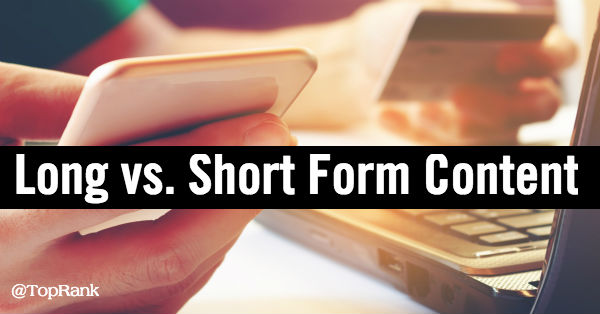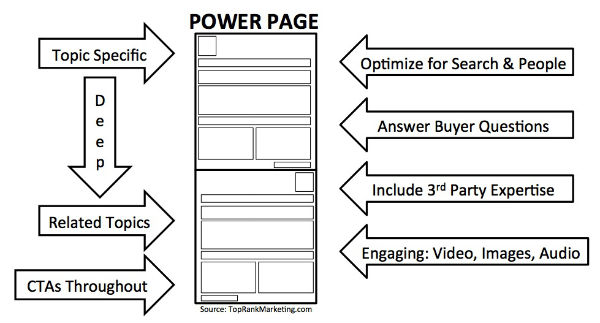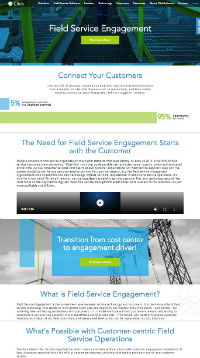Buyers have questions and sellers better have answers that are easy to find, informative and inspiring. This is the cornerstone behind “Best Answer” content marketing strategy. But what qualifies as best answer content? How deep or wide do you need to go on a topic?
Is it better to use short form or long form content for content marketing?
From informal observations like ours on video and social media to formal studies in the marketing industry, much has been said about the topic of content length with some pretty compelling arguments in favor of long form content.
For example, BuzzSumo’s 2018 Content Trends Report says long form content consistently gains backlinks which is great for referral traffic and SEO. Another study from BuzzSumo and AppSumo reported in their analysis of 100 million articles that the longer the content, the more shares it gets. In Backlinko’s own research of 1 million Google search results, comprehensive content significantly outperformed shallow content. In that same study, the average word count of a Google first page result was found to be 1,890 words.
Does this mean you should always write 1,890 word blog posts? Do customers always want to binge on content?
Savvy marketers understand that statistical generalizations can be useful for making persuasive arguments but not always so useful in practice. As a long time B2B content marketing practitioner, here’s what I’ve found to be true when it comes to long form content.
Engagement and reach are intertwined when it comes to digital content. Search continues to be an important connector of brand solutions content with buyers at the very moment they need it. A number of analysis identifying the content types that fare best in search have superficially associated length with “better”.
“The idea that long form content is best can be misleading. Content depth and utility trump length for search engines and buyers.” @leeodden
The reality is that depth is better than length. It just happens that much of the content that covers a topic thoroughly also has length. But it is not the number of words that has merit. It’s the words used, structure, usefulness, citations and associated entities that matter most for search engines trying to understand and rank “best answer” content and people looking for solutions.
Google is essentially an answer engine and if companies want to be the “best answer” for what their potential customers are looking for, they’ll want to invest in content that is comprehensive and engaging on the topic.
For powerful content, publish powerful pages. One of the tactics to become the best answer for topics that are and important to customers and that represent the solutions from the brand are what we at TopRank Marketing call, “Power Pages”.
Best Answer Content works in tandem with the idea of Power Pages, which are encyclopedic treatments of a specific topic and will often serve as the hub of an idea with spokes to tangential and related ideas in the form of other pages or posts. Insights about customer interests, goals, pain points and questions about the topic all inform the creation of relevant Power Pages that meet the demands of customer intent.
The information architecture with Power Pages is very logical with attention to be both search and buyer friendly. Exploration of an issue from what it is, to how it can be solved, to evidence of credibility and triggers to take action can all be found within a single Power Page and it’s ecosystem of subordinate or related content.
For example, the Power Page below from Click Software on the topic of Field Service Engagement has performed incredibly well in search, on social and with customers.
Powerful content drives search traffic. While Power Pages play an important part of a Best Answer Content Marketing Strategy irregardless of how that content is promoted, successful marketers are paying special attention to their ability to attract customers at the moment of need. Of course I’m talking about Search Engine Optimization.
Optimization should be part of your ongoing content process. There are many ways companies are making it easier and more effective for Google to crawl, index and rank brand content. From ensuring pages are fast and mobile friendly with useful, logical content to optimizing for clickthrough in SERPs and adding signals of credibility / authority to content through attracted links from credible sources, influencer quotes and credible content like statistics and cited excerpts, the list of search performance optimization tactics is always evolving.
Optimize for people and search engines. Here is a list of 9 potential places where you can decide to put your target keyword phrase in your (long or short) power page. as long as it flows well and satisfies your brand standards:
- Title tag – this is also what is often used to pre-populate social shares and used for bookmark text
- On page title using the H1 tag
- Body copy of your page – of course
- URL of the page with words separated by hyphens: firstword-secondword-thirdword.html
- Image alt attribute – good for usability
- Meta description to inspire clicks when displayed in search results
- As synonyms or concepts related to the focus phrase (a must if you cover a topic deeply)
- In the form of questions that customers might ask – then you can answer them in your content
- Anchor text to related pages on your site
Remember, these are just options for optimizing your power page – you don’t need to use them all. The first priority should be to use the target keyword phrase with the frequency that will be useful to the reader.
So, is long form content really better than short form content? The answer is that your content should be whatever length and depth that will satisfy customer efforts to discover resources, understand solutions and to take action towards a solution. As questions these criteria are important to answer with every blog post or article:
- What is it?
- How does it work?
- What do I do next?
For some topics, audiences and situations, the best approach might be content answers that go deep on a topic, but are not necessarily long on words. In other situations a topic might require a lengthy treatment in order to satisfy the buyers need to understand, consider and decide. The key is to create and optimize content that fulfills the customer’s effort at discovering, learning and deciding on a solution.
When it comes to long vs. short form content, the lesson to learn is to avoid just checking off boxes that say you need to write 2,000 (or 1,890) words to satisfy Google. Know your customers well enough through data to create a best answer content strategy and content mix that is relevant, optimized for discovery, useful and actionable. Make the length of your content more about the depth of topic necessary to satisfy customers and their search intent and less about fulfilling a generalization about content that might not even represent what your customers care about.
This post was inspired by an article that I was interviewed for on Marcom Insights.
Gain a competitive advantage by subscribing to the
TopRank® Online Marketing Newsletter.
© Online Marketing Blog - TopRank®, 2018. | Power Pages and Best Answer Content: Should You Go Long or Short Form? | https://ift.tt/2wiHYzh
The post Power Pages and Best Answer Content: Should You Go Long or Short Form? appeared first on Online Marketing Blog - TopRank®.
from Online Marketing Blog – TopRank® https://ift.tt/2DL2S15
via IFTTT



